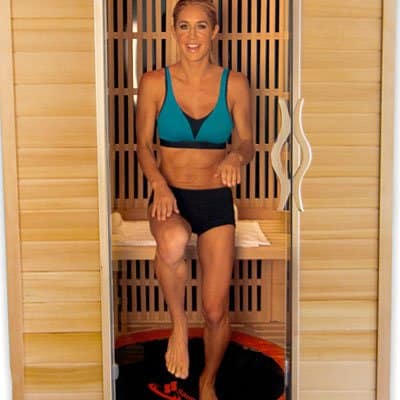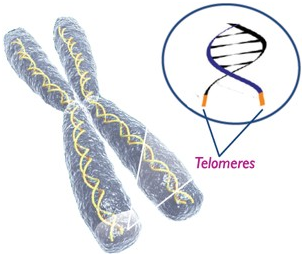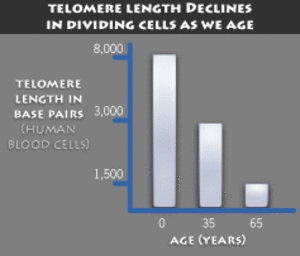5 Biohacks for Longer Life, Athletic Prowess and A Better Brain
Few things you can do can have a greater positive health outcome than taking vitamin D and regularly using a sauna. There’s plenty of science here, but the biohacks couldn’t be simpler, and the outcomes more promising.
BY THE time you finish this article and watch the video, you’re going to rush to your nearest sauna after a quick stop for a bottle of vitamin D.
What you’ll learn are five simple biohacks that can improve your life span, athletic prowess and brain performance, courtesy of Rhonda Patrick, a very smart woman who holds a PhD in biomedical science, and does extensive research on aging, cancer, metabolism and nutrition.
Some of the things we’ll touch on are:
- The science of epigenetics and how it explains what genes are “turned on” and “turned off”.
- The importance of vitamin D, and the lack of it in the general population.
- Why lifespan is dictated by telomeres, and how a confluence of lifestyle factors affect them for ill or good.
- How hyperthermic conditioning via a sauna can improve muscularity, endurance and brain function.
Let’s dig in…
For those of you who rather watch than read, go right ahead and see what Dr. Patrick lecture on these topics:
For those of who rather read (and for those scratching their heads, being a bit confounded after watching the video), I took several hours to review, interpret and write what the good doctor revealed.
Two articles that complement the material presented here is one Dr. Patrick wrote for WellnessFX, and another for Tim Ferriss’ blog.
Without further ado, here are 5 Biohacks for Longer Life, Athletic Prowess and A Better Brain…
Biohack #1: Vitamin D for a longer, healthier life
Vitamin D is a fat-soluble vitamin that gets converted into a steroid hormone that regulates the expression of over 900 genes, which is 1/24th of the entire human genome, or “almost 5% of the protein-encoding genome.” writes “Anonymous” in the Comments below. What that means is that vitamin D has a big impact on your biology!
For instance, one thing vitamin D does is to turn on the expression of a gene called “tryptophan hydroxylase”, which in a study conducted by Dr. Patrick and her college Dr. Bruce Ames, found that serotonin, oxytocin, and vasopressin — three brain hormones that affect social behavior — are all activated by vitamin D. (1)
Tryptophan hydroxylase is a the rate-limiting enzyme that converts tryptophan into serotonin. Serotonin regulates a wide variety of behaviors, such as anxiety, aggression, learning and memory.
Vitamin D also regulates the aging process by its impact on telomeres. I’ve written about telomeres before. A good introduction to what they are and what they do can be found in my article, Three Months To Longer Life.
We need to know about telomeres a bit to understand how vitamin D affects them.
Telomeres are tiny caps at the end of your chromosomes. A helpful visualization is to imagine them like the plastic tips at the end of shoelaces. Every cell in your body has 46 chromosomes, and your DNA is wound up inside these chromosomes. The telomere caps that are at the end of your DNA protect it from oxidative damage, from inflammation and other things that corrupt DNA and create irreversible damage.
Telomere length is a biomarker for aging. Typically, the younger you are, the longer are your telomeres. As you age, your telomeres shorten. We lose about 21 “structural units” from our telomeres each year, which happens as cell division occurs. Eventually, there are none left, and the cells die or go into senescence, and thereby no longer function.
Various studies have examined how vitamin D might influence telomere length. One particular study covered in the American Journal of Epidemiology measured the vitamin D of 2100 different pairs of twins. They found that those twins with the highest levels of vitamin D serum had the longest telomere length, and those with the lowest levels had the shortest telomeres.
That difference in telomere length corresponded to a five-year difference in biological age. Remember, we’re talking twins here who are chronologically and genetically identical, and yet those with lower vitamin D serum levels were aging faster.
This underscores the value of the relatively new science of epigenetics, the study of genetics, cellular and physiological phenotypic trait variations that are caused by external or environmental factors that switch genes on and off, and affect how cells read genes instead of being caused by changes in the DNA sequence.
Epigenetics tells us our behavior matters. Mightily! What you do, what lifestyle you embrace can activate (turn on) and deactivate (turn off) gene expression.
Vitamin D increases the expression of genes that are involved in repairing damaged DNA. DNA repair enzymes lowers DNA damage, the type of damage that can shorten telomeres.
Despite the importance of vitamin D, in Dr. Patrick’s presentation below she cites a National Health and Nutrition Examination Survey finding that 70% of the U.S. population does not have adequate levels of vitamin D.
There could be several reasons for this, such as the ability of sunscreen and dark skin to filter out UVB light, thus preventing the body to make its own vitamin D from sunlight. Or the fact that about two-thirds of Americans (and much of the rest of the industrialized world) are overweight.
Body fat can regulate the bioavailability of vitamin D. This is because vitamin D is fat-soluble and is stored in body fat. The more body fat you have the less the vitamin D can be released into the bloodstream.
Finally age is a factor. A seventy-year-old makes 1/4 of less vitamin D produced at age 20; that’s a reduction in such a person’s skin’s ability to synthesize vitamin D by around 75%! (Again, thanks to “Anonymous” in the Comments for this tidbit.)
What to do? If you’re overweight, over 40 or have dark skin, supplement with a type of vitamin D called “vitamin D3“. It’s quite common. Go for 3,000 to 5,000 IUs per day. Check to see if you doctor concurs.
Biohack #2: Meditate to activate telomerase
Another thing that can change the expression of genes is meditation. Meditation has been shown to increase an enzyme known as telomerase, and it can rebuild the length of telomeres.
Exercise also increases telomere length. Once again, twins show this to be true. In a study Dr. Rhonda refers to in her video above, 2501 twin pairs were studied. The most active had the longest telomeres, and the most sedentary had the shortest.
Shockingly – remember these are twins – the biological age difference between those most physically and least physically active was a whopping ten years!
Meditation also makes you smarter.
Increases expression of genes that grow new brain cells and the size in the hippocampus, the part of your brain used involved in learning and memory.
How does this gene expression happen?
There’s something called “epigenetic marks” that are on top of your DNA and will turn genes on and off. They are regulated by micronutrients such as Vitamin D, by exercise, stress and sleep.
Interestingly, epigenetic marks not only change the expression of your own genes, but can also be passed on to your children and grandchildren, which some mouse studies verify, and the detail about which can be viewed starting at time marker 14:00 in Dr. Patrick’s video.
What to do? Everyday, carve out 15 minutes, grab a pair of stereo headphones, find a sound track of binaural and/or isochronic beat tones on Youtube (here are some), sit or lie down and experience bliss. Learn more about this technique in my article, 4 Research Studies That Prove Mediation Increases Lifespan.
Biohack #3: Hyperthermic conditioning increases cardiovascular conditioning
Get in a sauna and then go take a long run. Doesn’t matter if it’s sweltering outside.
Turns out that consistent use of a sauna can induce physiological adaptations that enable greater tolerance for heat stress.
Why care about this?
Because when exercising the increase in core body temperature creates stress, and a sauna can improve your hyperthermic conditioning, thereby enhancing endurance, lean muscle mass, as well as improving brain function.
What happens when regularly using a sauna is that your body becomes conditioned to accommodating high ambient temperatures and the resulting stress response. This has a carryover effect when your body’s temperature increases through exercise, because blood flow to the muscles improves, which increases nutrient uptake to muscles, and better glucose and oxygen transport to muscle cells.
In addition, hyperthermic conditioning:
- Improves endurance training outcomes because muscles rely less on local glycogen stores;
- Increased blood flow to the heart improves cardiovascular conditioning, as it lowers the heart rate required for the same workload;
- Allows improved heat acclimation so your body begins to sweat at a lower core body temperature.
You get all these benefits from 30 minutes sitting in a sauna twice a week. After about six weeks of such heat work, runners experienced a 32% increase in the distance they could run before exhaustion, and that corresponded with a 7% increase in plasma volume and a corresponding 3.5 percent increase in their red blood cell count which is thought to be a compensation for increased plasma volume. (This is all in the video.)
What to do? Find a sauna and sit in it, but not for too long. If you’re a newbie, try 10 minutes, then shower and take a break for 10 minutes and repeat once or twice more. Gradually increase the time spent in the sauna.
Biohack #4: Hyperthermic Conditioning Increases Muscle Mass
This happens via three mechanisms:
- The induction of Heat Shock Proteins (“HSP”).
- The induction of Human Growth Hormone (“HGH”).
- By improving insulin sensitivity.
Let’s touch on each of these a bit.
Heat Shock Proteins are activated by the stress put on the body by heat.
This is a good example of “hormesis”, a biological phenomenon whereby a beneficial effect (improved health, stress tolerance, growth or longevity) results from exposure to low doses of an agent that is otherwise toxic or lethal when given at higher doses. (2)
The stress response from the heat is to increase the expression of genes that can deal with it, which are the HSP. They repair the proteins damaged by the heat, prevent oxidative stress, and improve glutathione recycling.
Given this, HSP can cause a net increase in protein synthesis, which is necessary to maintain, or increase muscle mass. The workforce load of the exercise stresses and breaks down muscle tissue; the protein synthesis is necessary to build it back up and make the muscle larger and stronger.
With hyperthermic conditioning via the sauna, the body develops a higher expression of HSP even under normal temperatures caused by exercise, resulting in an increased capacity for the body to favorably respond to the exercise.
Human Growth Hormone can be increased by sauna use, and it facilitates muscle growth through:
- IGF-1 (“Insulin Growth Factor 1), a protein that has an anabolic effect, by increasing mTOR (a type of protein that regulates cell growth, proliferation, motility and survival).
- Decreasing protein degradation by activating so-called FOXO genes that regulate expression of genes involved in cell cycle arrest, apoptosis, DNA repair and oxidative stress resistance. (3)
The effects of sauna use on HGH are dependent on:
- Time in the sauna,
- Frequency, and
- Temperature
HGH can be increased two fold over baseline by two back-to-back 20-minute sauna sessions at 176 degrees Fahrenheit (80 degrees Celcius).
If that’s insufficient, you can get more extreme. Two one-hour sauna sessions separated by at 30 minute cooling off period for three consecutive days increased HGH expression over baseline by 16 fold!
Insulin sensitivity can be improved by sauna use. To understand this, fist know that besides having a role in glucose homeostasis, insulin also has a role in protein metabolism.
When you’re sensitive to insulin (the preferred condition), and it’s released, the body takes up glucose in its muscle cells. This action affects protein synthesis by activating Akt which augments protein synthesis by mTOR, and also increases the uptake of amino acids (protein) into muscle cells.
To understand how this relates to the sauna, we need to examine mice studies. When diabetic, obese mice were put in their version of a sauna for three 30-minute sessions per week for 12 weeks, they showed a 31% decrease in insulin production (became more insulin sensitive).
What to do? As above: Find a sauna and sit in it, but not for too long. If you’re a newbie, try 10 minutes, then shower and take a break for 10 minutes and repeat once or twice more. Gradually increase the time spent in the sauna.
Biohack #5: Hyperthermic Conditioning Makes Your Brain Better
The science behind why and how sauna conditioning makes your brain better confounds me at the moment, but suffice to say that hypertermic conditioning has been shown, says Dr. Patrick to:
- Enhance learning and memory, and
- Improve the connection between brain neurons.
What to do? Once more: Find a sauna and sit in it, but not for too long. If you’re a newbie, try 10 minutes, then shower and take a break for 10 minutes and repeat once or twice more. Gradually increase the time spent in the sauna.
Sauna Update:
Your Takeaway
Yeah, another long post, so let’s carve these biohacks down to the bone.
You need vitamin D to be healthy and have a good chance for a long and healthy life. Serum levels in your body are impacted by:
- Age
- Skin pigmentation
- Body fat
- Sun exposure
- Sun screen
- Supplementation
The older, darker, fatter, more sun screened and less sunny you are, the more you need to supplement.
Telomere length is a proxy for life span, and it is impacted by:
- Vitamin D
- Exercise
- Stress
- Sleep
Act accordingly.
Hyperthermic conditioning via a sauna can:
- Improve cardiovascular conditioning
- Muscularity
- Insulin sensitivity
- Brain function
Go find a sauna and use it liberally. But don’t overdo it.
P.S. For more of Dr. Rhonda Patrick’s fine work, visit FoundMyFitness.
Last Updated on June 21, 2022 by Joe Garma







